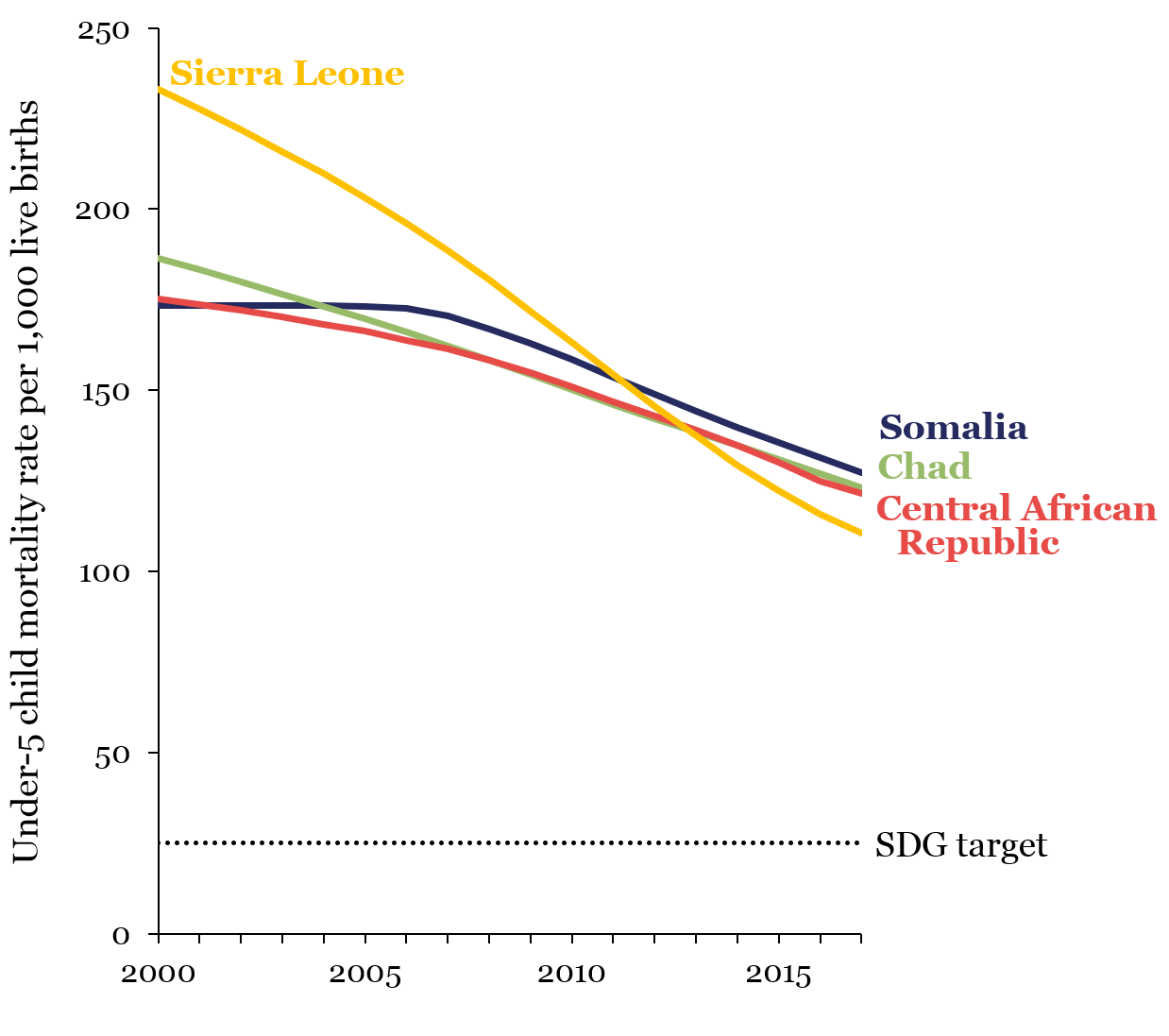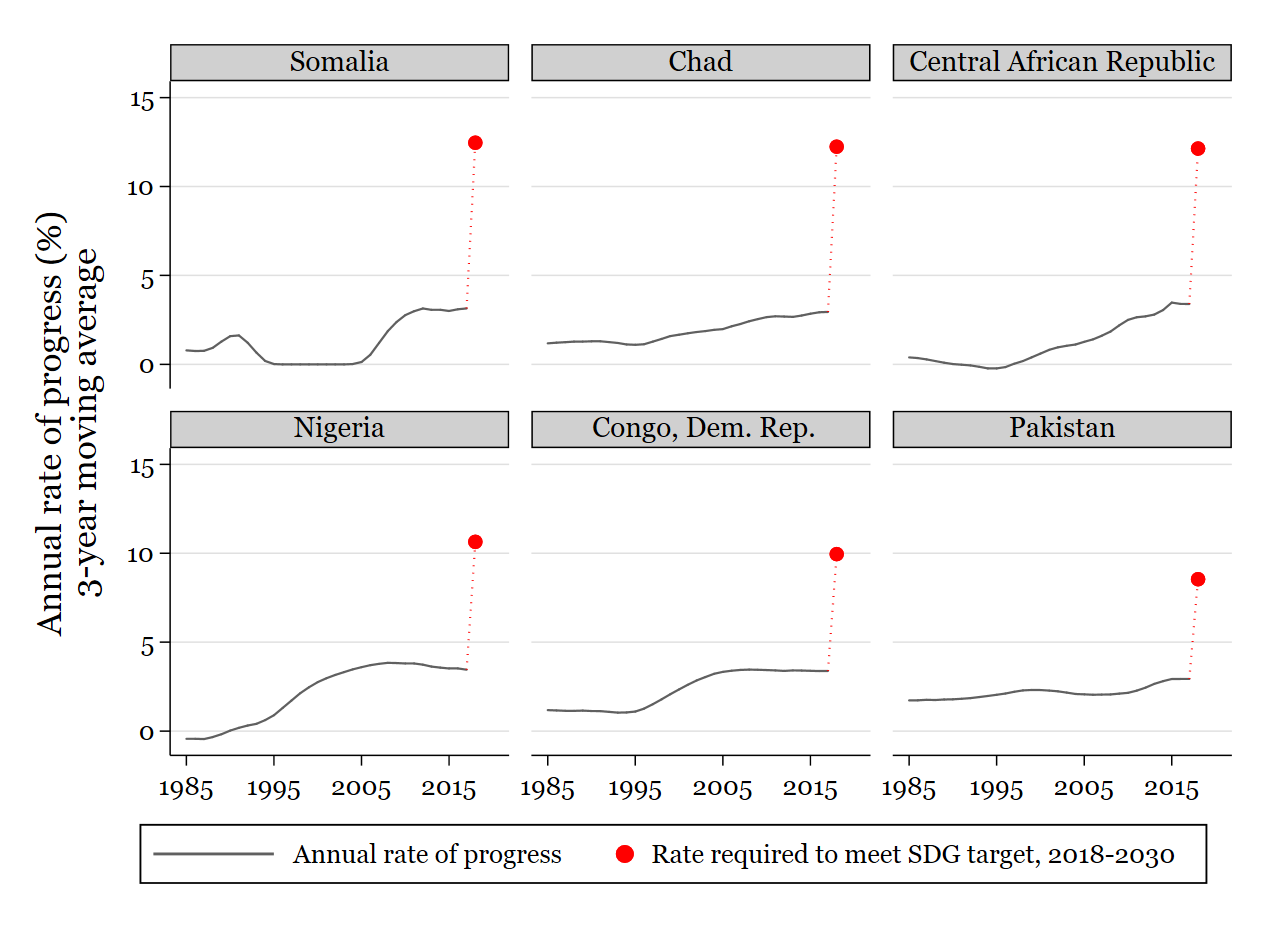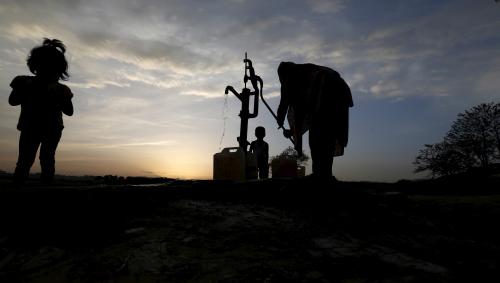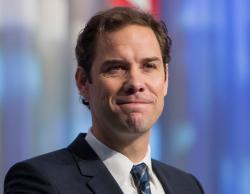Sometimes even the world’s biggest challenges come with their own silver lining of hope. Recent U.N. data show that 5.4 million children under five died last year, mostly of preventable causes related to poverty. In countries with the worst problems, one in eight children doesn’t live to see their fifth birthday, compared to one in 250 or better in many advanced economies. These numbers highlight vast inequalities in life opportunities around the world, but they should not be a cause for despair. Instead, there is reason for cautious optimism and focused pragmatism in tackling the world’s child survival challenge.
Here we highlight three key aspects of child survival trends, applying methods from some of our recent papers (e.g., here and here) to the new official data release.
1. Even countries the furthest behind are making progress
No country’s situation is hopeless—far from it. In 2017, the three countries with the highest child mortality rates were Somalia (127 deaths per 1,000 live births), Chad (123 per 1,000), and Central African Republic (122 per 1,000). As shown in Figure 1, all three countries have been experiencing gradual ongoing declines in mortality. Since 2005, each has seen a full 27 percent reduction.
There is more good news. Looking slightly further back to 2000, Sierra Leone previously had the world’s highest mortality rate, at an estimated 233 deaths per 1,000 live births as of that year, equivalent to nearly one in four children. But since then Sierra Leone has cut its child mortality rate by more than half, down to 111 deaths per 1,000 live births as of last year.
Together, these trends represent extraordinary human progress. For not only is it the case that the world’s most challenged countries have been making consistent gains, but the definition of “most challenged” has itself improved dramatically. Somalia’s child mortality rate in 2017 may be the highest in the world, but it is fully 45 percent lower than Sierra Leone’s mortality rate in 2000. The shift represents a 3.5 percent average annual rate of improvement in the world’s worst-case situation for child mortality.
Figure 1: Child mortality rate in countries furthest from target in 2017

2. Three countries account for half the children’s lives at stake
Targeted efforts will be required to achieve the Sustainable Development Goals (SDGs), established by all countries in 2015, very much including target 3.2—to ensure all countries achieve a child mortality rate of no more than 25 deaths per 1,000 live births by 2030. Building on methods previously presented in McArthur, Rasmussen and Yamey and Kharas, McArthur and Rasmussen, we can compare each country’s recent trend to the trajectory required to reach the 2030 SDG target, and in turn identify the number of lives at stake in the 48 countries with complete data that are not yet on track (141 countries are already on track; three small island states are off track but lack relevant demographic data). Our calculations indicate that, on current trajectory, approximately 9 million lives are at stake, with three countries accounting for more than half the total: Nigeria at 29 percent, Pakistan at 13 percent, and the Democratic Republic of Congo at 12 percent. The remaining lives at stake are spread across 45 countries. So while all off-track countries merit concerted international support to achieve the SDG standard, Nigeria, Pakistan, and the DRC are of unique human consequence for concerted international efforts.
Figure 2: Concentration of children’s lives at stake under current SDG trajectory

3. SDG success requires significant acceleration
The 2030 child mortality target can only be achieved through major accelerations of progress in high mortality countries. Figure 3 shows the extent of the leap required in the three countries with the highest 2017 child mortality rates (Somalia, Chad, and Central African Republic) and three countries with the largest number of children’s lives at stake (Nigeria, Pakistan, Democratic Republic of Congo). The solid line shows the recent annual rate of progress and the red dot indicates the average rate of progress required between 2018 and 2030 to meet the SDG target. Three countries in the top row all require at least a tripling in their annual rate of progress; the three in the bottom row all need to see at least a doubling.
Figure 3: Leap in annual rate of progress required to meet target by 2030

Next stop: 2019
In September 2019, heads of state and government will gather at the U.N. for the first major political check-in on the SDGs. This will be a crucial opportunity for the world to take stock of global trends, diagnose how the world is doing, and identify where things most need to change. Essential new actions might range from an emphasis on technological innovations to bolstering health systems. In any case, when it comes to child survival, there is powerful evidence that even the world’s worst case situations are getting better. The cost of not improving fast enough can be measured in terms of lives at stake. The global story of children’s progress is impressive but not sufficient. September 2019 offers a political deadline for filling the relevant policy gaps.







Commentary
3 insights on child survival
October 18, 2018